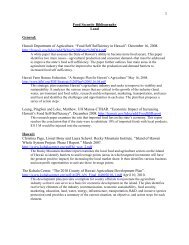Hawai'i Fisheries Initiative - The Hawaii Institute for Public Affairs
Hawai'i Fisheries Initiative - The Hawaii Institute for Public Affairs
Hawai'i Fisheries Initiative - The Hawaii Institute for Public Affairs
Create successful ePaper yourself
Turn your PDF publications into a flip-book with our unique Google optimized e-Paper software.
or Olive Ridley sea turtles have been<br />
reported in the bottomfish fishery,<br />
despite the turtles known to be in the<br />
same habitat regions. 252<br />
Regarding species in <strong>Hawaii</strong>an waters,<br />
federal protection under the Endangered<br />
Species Act 253 is accorded seven species<br />
of marine mammals, five species of<br />
sea turtles, and one species of seabird.<br />
Other marine mammals and seabirds<br />
are protected under the Marine Mammal<br />
Protection Act 254 or the U.S. Migratory<br />
Bird Treaty Act. 255 Potentially, a species<br />
can be listed both under the ESA and<br />
the MMPA. 256<br />
In the pelagics fisheries, the largest<br />
component of bycatch is sharks, primarily<br />
the blue shark, which have a high<br />
post-release survival rate. Sharks and<br />
other finfish are discarded <strong>for</strong> economic<br />
and regulatory reasons. In the past, many<br />
sharks were finned; however, both state<br />
and federal regulations now prohibit this<br />
practice. In 2001, 96 percent of the 45,000<br />
sharks caught in the longline fisheries<br />
were discarded, with the balance retained<br />
whole. Interactions with seabirds and<br />
sea turtles remain issues in the longline<br />
fisheries; there have been no reported<br />
interactions between longliners and<br />
<strong>Hawaii</strong>an monk seals since 1993, and<br />
very few interactions between longliners<br />
and ESA-listed whales. Research into<br />
sea temperatures is showing promise in<br />
locating potential turtle territory so that<br />
swordfish longliners, armed with this<br />
in<strong>for</strong>mation, can avoid that depth range. 257<br />
Changes in species release and handling<br />
procedures and fishing methods – such as<br />
side setting and the use of circle hooks –<br />
have shown to be effective means of<br />
reducing seabird and sea turtle bycatch,<br />
or dealing with caught species to limit<br />
physical damage or mortality. 258 Side<br />
setting shows potential <strong>for</strong> eliminating<br />
seabird bycatch in the longline tuna fishery<br />
and reducing bycatch by 87 percent in the<br />
longline swordfish fishery. 259 Side setting of<br />
longline gear moves operations from the<br />
back of the boats to the side; crew set the<br />
baited hooks close to the vessel’s side, and<br />
seabirds are unable (or unwilling) to dive<br />
on the bait. 260 <strong>The</strong> practice was voluntarily<br />
adopted by 15 percent of the Hawai‘ibased<br />
longline fleet be<strong>for</strong>e Wespac began<br />
to <strong>for</strong>mally consider including this seabirdavoidance<br />
measure in its regulations. 261<br />
Use of nets contributes to bycatch – fish<br />
drop out be<strong>for</strong>e harvest either injured or<br />
dead, and ghost (lost) nets continue to<br />
capture and kill fish, and destroy coral and<br />
valuable habitat. A major concern with<br />
lay gillnets is the entangling and killing<br />
of protected species such as sea turtles or<br />
monk seals. Lay gillnets have been called<br />
one of the most destructive near-shore<br />
fishing methods, snaring indiscriminately<br />
both targeted and non-targeted species,<br />
as well as destroying bottom habitat.<br />
Bycatch can amount to fifteen times the<br />
amount of targeted catch. Recently, DAR<br />
implemented gillnet regulations <strong>for</strong> size,<br />
time, and area limitations. 262<br />
56







